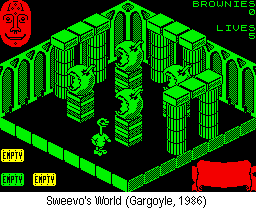|

By Lloyd Mangram
February
1986
Issue 25
|
|
Inspiration
for a cover image was lacking, so everyone was pleased
when Imagine's Mikie became a Smash since it
gave Oliver a subject suitable for his particular talents
- a figure seen in action within a dynamic composition.
The character of Mikie is so energetic he's simply burst
through the cover paper, scattering hearts in his wake
- the cover and the game neatly tied in with Saint Valentine's
Day. In a way it also acted as a symbol for the new
year beginning; CRASH was crashing through again . .
.
|
The cover's bounciness could also have been taken as a symbol
for a new face on the CRASH team. For the first time the reviewing
team figured in the masthead, and among the names was one
Mike Dunn. As they had been wont to do since CRASH started,
Ludlow lads with Spectrums dropped in after school hours to
see what was happening, and some of them were dragooned into
writing review comments. Mike was one such. Robin Candy told
everyone that Mike's school nickname was Skippy because he
skipped wherever he went, and this information was soon confirmed
when Roger Kean reported that he had almost been knocked flying
in the street as Mike skipped violently past him on the way
down a Ludlow hill. Skippy is a now a respectable bespectacled
college student with a far more sedate gait, but the nickname
still sticks.
On a more serious note February marked the start of a run
of cover paintings with which Oliver was less than satisfied,
though in retrospect some of them are outstanding. It wasn't
so much that they were poorly executed, more that he felt
uninspired by the subject matter. An illustrator requires
a brief for his work and previously he and Roger Kean had
worked on the ideas themselves. Naturally, the chosen subject
was therefore always one which Oliver enjoyed and the sort
of thing he excelled at. Now, with three magazines going,
he had to rely far more on the editors for their ideas and
briefs, and in the case of CRASH Graeme Kidd seemed to prefer
humorous subjects - Mikie was one and Jack The Nipper
notoriously so.
Still, this is no reflection on Mikie the game, which
got its Smash, the first of two that month for Imagine. The
other, also a Konami conversion, was the onomatopoeiac Yie
Ar Kung Fu, which received praise for its 'arcade style
playability', one reviewer commenting that Imagine was fast
becoming one of the best development houses in the country.
As you can tell from the enthusiasm, these were still the
heady days of coin-op conversions: a moment of freshness before
the tedium of overkill which would all too soon set in.
 Four
other games merited Smashes. Martech's Zoids finally
made it through; Electronic Pencil Co. had done a fine job,
maintaining a high standard of graphics and providing an engrossing
game. Their innovative approach made mincemeat of the notion
that a licence from something as childish as a series of toy
monsters means a thinly-disguised piece of marketing schlock.
Zoids is Martech's monument for posterity. Ultimate
looked back on form with Gunfright, an entertaining
advance on their Nightshade, while Gargoyle Games proved
they had more in them than complex graphic adventures of the
Dun Darach type. Sweevo's World had something
in common with Ultimate's Knight Lore and Alien
8 style of presentation, but took it further to provide
a game both compelling to play and very funny. In fact it
was to be the precursor of a genre which would reach fulfilment
in Head Over Heels. Derek, meanwhile, was praising
Activision's adventure Mindshadow while berating their
lack of marketing for it - an omission the company was not
usually noted for . . . Four
other games merited Smashes. Martech's Zoids finally
made it through; Electronic Pencil Co. had done a fine job,
maintaining a high standard of graphics and providing an engrossing
game. Their innovative approach made mincemeat of the notion
that a licence from something as childish as a series of toy
monsters means a thinly-disguised piece of marketing schlock.
Zoids is Martech's monument for posterity. Ultimate
looked back on form with Gunfright, an entertaining
advance on their Nightshade, while Gargoyle Games proved
they had more in them than complex graphic adventures of the
Dun Darach type. Sweevo's World had something
in common with Ultimate's Knight Lore and Alien
8 style of presentation, but took it further to provide
a game both compelling to play and very funny. In fact it
was to be the precursor of a genre which would reach fulfilment
in Head Over Heels. Derek, meanwhile, was praising
Activision's adventure Mindshadow while berating their
lack of marketing for it - an omission the company was not
usually noted for . . .
After its recent run of successes - Critical Mass
and Saboteur - we featured Durell. Robert White's company
had been with us since the earliest Spectrum days and had
always strived to be both good and different. It seems sad,
as I write this, to reflect that Durell no longer exists in
its previous form, sold, as it was at the 1987 PCW Show, to
Elite . . .
|